Биологические науки. Рубрика в журнале - Бюллетень науки и практики
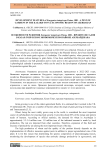
Статья научная
He results of studies conducted in 2022-2023 are reflected. Periods of activity of Eurygaster integriceps , a serious pest of grain farming in the Shamkir district, have been identified. This is one of the main grain regions of Azerbaijan. The studied species, when present in high numbers, causes serious damage to grain farms. It has been established that the pest under these conditions produces one full generation and is more active in the agrocenosis from May to June. A phenological calendar is presented, which can be used in the development of planned measures for protection against this pest.
Бесплатно
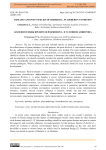
Diseases and pests species of Berberis L. in Absheron condition
Статья научная
The use of disease and pest resistant species in landscape design contributes to the effectiveness of green plantings. For this purpose, the pests Berberis L. and control measures in the dry subtropical climate of the Absheron Peninsula were studied. The main methods of disease control and prevention are considered. In conclusion, it is concluded that disease-resistant species should be chosen for landscaping; it is necessary to determine the optimal timing of plant growth and development; you should constantly monitor the general condition; dried branches and leaves must be periodically cleaned; autumn leaves should be collected and burned in winter as they contain pathogens. When a disease or pest is detected, chemicals should be used to prevent its development.
Бесплатно
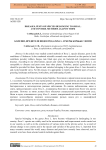
Diseases, pests of species belonging to Rosa L. and control methods against them
Статья научная
In the article were studied control methods of Rosa L. species diseases, pests in the conditions of Absheron. In the conducted scientific research were observed on the species in local conditions powdery mildew, fungus, rust, black spot, gray rot, bacterial and cytosporosis cancer diseases. According to our observations, species and varieties belonging to the genus Rosa L. are susceptible to diseases and pests more than other plants. Therefore, special agrotechnical care should be provided for them. Species and varieties belonging to the genus Rosa L. have decorative and exotic beautiful views. For this reason, it is appropriate to widely use different types of roses in greening, landscape architecture, horticulture, and landscaping of parks.
Бесплатно
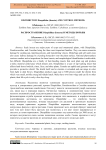
Distribution Diaspididae (Insecta) and control methods
Статья обзорная
Scale insects are major pests of crops and ornamental plants, with Diaspididae, Pseudococcidae, and Coccidae being the three most important families. They can cause economic damage by sucking sap, injecting poisons, and transmitting viruses. Mealybugs and soft scales may also cause indirect damage by excreting honeydew onto the plant surface. National phytosanitary services conduct active inspections for these insects, and morphological identification is achievable, but difficult. Diaspididae are a family of fast-breeding insects that suck plant sap and produce a sticky material called pad, which attracts ants. Diaspididae is a type of sap-sucking insect that affects hard-leaved orchids, citrus, ficus, and other plants. Females are aphids and generate wax that provides a protective shield. The shield itself can be circular or extended and can range in color from light to dark brown. Diaspididae produces eggs (up to 3000 pieces) under the shield, from which very small, mobile young individuals hatch. Males have two front wings and can fly to other plants; their life cycle is only a few days long.
Бесплатно

Статья научная
Samples were taken in order to study the distribution of Meloidogyne incognita in different organs (root and lower part of the stem) of potato plants in the farms of Gazakh-Tovuz economic region. During the examination of the samples by the Berman method, it was determined that the infection of potato with M. incognita was 46.7% in Gadabey district and 31.4% in Gazakh district. High intensity of infection was recorded in Shamkir (2-30 nematodes), Gadabey (2-29 nematodes), Tovuz (2-25 nematodes), and relatively low intensity in Gazakh (3-15 nematodes), Aghstafa (2-17 nematodes) regions. A total of 304 nematodes were found in the samples taken from the researched areas. The article provides information about the symptoms of the disease caused by the nematode M. incognita in plants, and the life cycle is reflected in a picture. Taking into account the serious economic damage caused by M. incognita species to the farms, recommendations were given regarding appropriate measures to combat its spread. M. incognita causes severe changes in the physiology, morphology and growth of the potato plant causing leaf wilting. The disease (nematodosis) occurring in the potato plant causes various changes in the above-ground and underground parts of the plant. The effect of M. incognita on the above-ground parts of the plant is manifested by symptoms such as retardation of plant development, yellowing of leaves, chlorosis of leaves, complete destruction of plants and poor growth of shoots. The symptoms of the underground part of the plant are manifested in the form of deformation of the roots, knotted roots, the formation of tumors and bumps. The most characteristic symptom of M. incognita when the infestation is high is the formation of nodules of different sizes (15 mm) on the primary and secondary roots.
Бесплатно
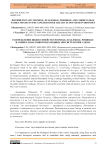
Статья научная
Our research revealed 20 species of Bivalvia, 1 subspecies and 1 variety of the Sangzor River and its surrounding aquatic species belonging to 4 families and 5 genera. Of the species listed in the table: Euglesa hissarica , E. (Casertiana) obliquata , Odhneripisidium polytimeticum are more numerous. They are found in the amount of 1-4 m per 1 m2. The rest of the species are relatively rare. Euglesa (Cyclocalyx) gurvichi , Odhneripisidium terekense , O. (Kuiperipisidium) issykkulense were first discovered in the basin of the Sangzor river. These Bivalves are crenophils and pelolimnophils living in springs depending on their habitat. The length of the Sangzor River and the presence of all biotopes in which mollusks live, made the river a favorable habitat for mollusks. However, it should be noted that while all species occur in the river, they vary in density.
Бесплатно
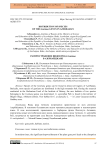
Distribution of species of the genus Gentiana in Azerbaijan
Статья научная
Species of the Gentiana genus can be found in almost all regions of Azerbaijan. Basically, most species of gentians are distributed in the high mountain belt. During the research conducted in the Herbarium Fund of the Institute of Botany, the new habitats of two species belonging to the Gentiana genus was determined. G. septemfida Pall. is found in the territory of Bilgah village, Absheron district. New habitat for G. asclepiadea L. - is Lesser Caucasus (north), Gadabey area.
Бесплатно
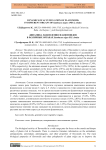
Dynamics of accumulation of flavonoids in different organs of Sambucus nigra and S. ebulus
Статья научная
The article is devoted to the phytochemical study of flavonoids in various organs of species of the Sambucus L. genus. The results of studying the dynamics of accumulation of the amount of flavonoids in the composition of S. nigra and S. ebulus species depending on the phases of plant development in various organs showed that during the vegetation period the amount of flavonoids undergoes a sharp change. It was established that in the generative organs of the studied species S. nigra and S. ebulus , the maximum amount of flavonoids accumulates in flowers (7.34%, 5.58%, respectively), the minimum amount in green fruits (1.91%, 2.83%). In the vegetative organs, the maximum amount accumulates in the leaves (4.94, 4.91%), and the minimum amount in roots (0.95%, 0.67%) and stems (1.46, 1.32%). The results obtained are of practical importance, since they indicate the possibility of using various plant organs as a source of raw materials for the production of flavonoids.
Бесплатно
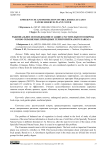
Efficient use and protection of the Lesser Caucasus nature reserves plant cover
Статья научная
While using food crops, feed crops, medicinal plants found in nature reserves criteria for the rare and endangered species should be met the International Union for Conservation of Nature (IUCN). Although there is wild fruit spread in 12 Families, 22 Genera belong to 46 species are not used effectively in nature reserves. Appletree, Arachis, Pyrus, Sea Buckthorn, Mespilus, Crataegus, Rubus, Cornus, Ribes, etc. are considered expedient to use the raw material reserves of these fruits for industrial purposes.
Бесплатно
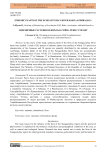
Endemic plants of the Sumgayitchay river basin (Azerbaijan)
Статья научная
In the course of the study, endemic plants of the flora of the Sumgayitchay River basin were studied. A total of 265 species of endemic plants were studied, of which 215 species are characteristic of the Caucasus and 50 species are naturally distributed in the endemic zone of Azerbaijan. Endemic plants of the flora of the Sumgayitchay River basin are systematically analyzed for the presence of taxa. Of the 215 Caucasian endemic species, 36 species belong to the family Asteraceae, 27 to Fabaceae, 17 to Brassicaceae, 16 to Rosaceae, 14 to Poaceae, 14 to Caryophyllaceae and 10 to Ranunculaceae. Of the 266 species of higher plants listed in the Red Book of Azerbaijan, 62 rare and endangered plants are common in the Sumgayitchay River basin. Plants with a new habitat were taken into account, a new distribution area of 14 plant species was determined. The Ministry of Ecology and Natural Resources of the Republic of Azerbaijan has submitted proposals for the conservation of the region’s biodiversity and the protection of flora.
Бесплатно
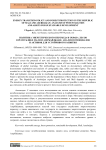
Статья научная
The energy transition is a challenge and an urgency for the world facing the scarcity of fossil fuels and their impacts in the ecosystems by climate change. Through this study, we wanted to assess the potential of new and renewable energies in the Republic of Mali and Azerbaijan in view of their promotion for the preservation of forest areas, in a world facing the challenges of global warming. The methodology was based on documentary collection and documentary exploitation and analysis of cartographic data, tables and other figures. The study revealed to us the high frequency of the potential of these so-called energies, especially solar in Mali and hydraulic, wind and solar in Azerbaijan and the commitment of the authorities of these States to promote the energy transition but also the dependence of these States on fossils such as: oil and gas. The Republic of Azerbaijan exports fossil fuels and Mali depends on imports. The transition to alternative energy resources will undeniably make it possible to reduce greenhouse gas emissions at the global level and to preserve forest ecosystems in both countries.
Бесплатно
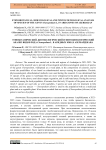
Статья научная
The research was carried out in the arid regions of Azerbaijan in 2021-2023. The main goal of the research was to provide a bioecological and phytocoenological analysis of species of the genus Chenopodium , widespread as a weed plant, in the composition of coenosis, and to reveal the possibilities of use based on ethnobotanical surveys among the population. Floristic, phytocoenological, ethnobotanical methods were used during the research. It was determined that 15 species of the genus in Azerbaijan flora are more widespread in the plains and mid-mountain belt, mainly in the desert, semi-desert steppe vegetation, and in cultivated areas. During the surveys conducted among the local population, it became clear that only 10 species of the genus are used, of which 5 species are used only as wild vegetables, 3 species are used only for treatment in folk medicine, and one species - Chenopodium album is used by the population both as a medicinal plant and as a vegetable plant. It has been recorded that one species ( Chenopodium foliosum ) of the genus is used as a dye plant.
Бесплатно
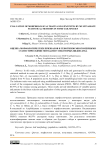
Статья научная
In this study, evaluated some morphological traits and genotypes by multivariate statistical methods in some oak species ( Q. castaneifolia C. A. Mey, Q. pedunculiflora C. Koch., Q. iberica Stev., Q. macranthera Fisch. & C. A. Mey ex Hohen, Q. ilex L.). 910 leaves were sampled from 91 trees, 8 population across Azerbaijan, and 6 morphological traits were assessed. The indicator traits were analyzed using multidimensional statistical analysis for each species. As a result of the component analysis, the three-pointer element (PRIN1, PRIN2, PRIN3) explained 86.97% of the variance among genotypes. These results provide identification of valuable species and patterns in the future selection and application of other genetic programs on the improvement of oaks in Caucuses.
Бесплатно
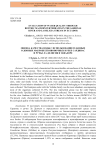
Статья научная
The present study characterized the macrobenthic entomofauna of the Sardinas river and the La Delicia stream. Their environmental quality water was determined by applying the BMWP/Col (Biological Monitoring Working Party for Colombia) index in two sampling points, distributed in the Sardinas river and La Delicia stream, during the months of May and June 2017. For its collection, a Surber net was used. In the laboratory, they were classified and identified in class, order and family levels. The specimens were analyzed by calculating the richness (S), abundance (N) and relative abundance (%). A total of 90 individuals belonging to 16 morphospecies were collected. The Hemiptera order with the Veliidae family was the most abundant, encompassing most of the organisms collected 33.33%. The less represented group was the order Diptera with the family Tipulidae with 1.52% of the individuals collected. The water quality was Moderate for the river Sardinas (BMWP/Col 59) and Good for the La Delicia stream (BMWP/Col 75). The present study characterized the community of macroinvertebrates in the study area and the ecological quality of the studied bodies of water.
Бесплатно
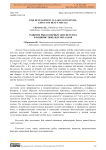
Fish development in lake ecosystems, effect of heavy metals
Статья научная
Heavy metals enter the water bodies and combine with the water buffer system, then turn into poorly soluble hydroxides, carbonates, sulfides and phosphates, and also form metal-organic complexes, accumulate in the bottom sediments and in general in the bodies of the fish fauna of the reservoirs of the area, seriously affecting their development. It was determined that the amount of Ca2+ ions varied from 17 mg/l to 112 mg/l, and the amount of Mg2+ ions from 5.5 mg/l to 83.5 mg/l, in other words, towards autumn. water hardness has increased. The amount of alkali metal (Na+ + K+) ions is much lower in spring than in summer and autumn. According to the cations, the amount of chloride and sulfate ions increases in autumn. Thus, the impact of anthropogenic factors on fish is diverse and manifests itself primarily in morphological anomalies and changes in the basic biological parameters of fish populations. The main of them is the reduction of productivity and the complete loss of their natural forms, the increase of individuals and the increase of mortality.
Бесплатно
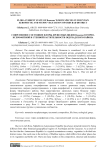
Статья научная
The current state of the tree family Rosaceae is considered. As a result of the research, the taxonomic composition, life forms, ecological groups, geographical areas and classes of tree species of the Rosaceae family, widespread in the mountain-xerophytic and steppe vegetation of the flora of the Ordubad district, were revealed. When characterizing the Rosaceae tree species of the mountain-xerophytic and steppe zone of the flora of the Ordubad region, it was established: Rosa - 14 (29.1%), Prunus - 6 (12.5%), Crataegus - 5 (10.4%), Pyrus - 5 (10.4%), Sorbus - 5 (10.4%), Cotoneaster - 5 (10.4%), Rubus - 3 (6.25%), Spiraea - 2 (4.16%) and 1 (2.08%) each of Malus , Louiseania and Pyracantha . The structure of the flora of the Ordubad region is dominated by species belonging to the genus Rosa L. They are part of the shrub steppes and form independent groups and unique communities.
Бесплатно
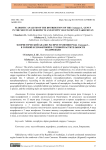
Статья научная
The article examines the floristic analysis of species belonging to the Crataegus L. genus in the mountain-xerophyte and steppe vegetation of Nakhchivan. As a result of the research, it was determined that 13 species of the Crataegus L. genus are found in the mountain xerophytes and steppe vegetation of the studied area. According to the analysis of life forms, the studied species are grouped into 3 subtypes of phanerophytes (mesophanerophytes, microphanerophytes and nanophanerophytes). According to the analysis of ecological groups, there are 7 species of mesoxerophytes, 4 species of xerophytes and 2 species of mesophytes. According to the analysis of geographical habitat types, xerophilic habitat type includes 8 species, Caucasian habitat type includes 2 species, and the remaining types are represented by 1 species as monotype.
Бесплатно
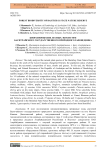
Forest biodiversity of Basitchay state nature reserve
Статья научная
The study analyzed the natural plant species of the Basitchay State Nature Reserve, located in the south of the Lesser Caucasus (Zangelan District), the population status of plants in the areas, the taxonomic composition of trees, shrubs and grasses. To this end, the Ministry of Ecology and Natural Resources of the Republic of Azerbaijan and the Institute of Dendrology of Azerbaijan NAS got acquainted with the current situation in the district. During the monitoring, satellite images, GPS coordinates, etc. were used. Soil samples brought from the site were examined for 14 indicators of the mineral composition using Palintest equipment, soil sets 400. Quercus iberica grows in the forest cover of the mountainous part of the region and Carpinus caucasica, 2 types of junipers: Juniperus foetidissima, J. depressa Stev. and hybrid, there are Pistacia mutica, sorbus, mulberry, willow, poplar, hawthorn, foxglove, mountain xerophilous plants, shrubs, blackthorn, etc. Q. araxina, Celtis caucasica Willd., Carpinus orentalis, Pistacia mutica, Acer iberica grow on dry stony slopes, Ulmus araxina Takht. = U. minor Mill. Pyrus salicifolia forms woodlands with juniper. Such forests are characterized by xerophytic shrubs: Atraphaxis spinosa, Lonicera iberica, Cerasus microcarpa, Ephedra intermedia Schrenk. et. Camei, Rhamnus pallasii and Paliurus spina-christi. As a result, 27 species of trees, 18 shrubs and 11 species of herbs have been registered in the Basitchai State Nature Reserve. Of these species, 17 rare, endangered trees, 3 shrubs, 3 grass species, 6 trees and 2 shrubs of relict and endemic species have been identified.
Бесплатно
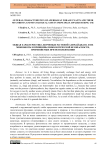
Статья обзорная
As it is known, all living things constantly exchange food and energy with the environment in order to continue their life activities and participate in the ecological functions they perform in nature, and this situation is ecologically both producers (plants), consumers (animals), and reducers (fungi). and bacteria). Nevertheless, the dependence on the environment of consumers as well as reducers is a more sensitive feature than that of producers, since both of the latter, i.e., fungi and animals, are heterotrophs due to their nutrition, i.e., because they cannot carry out the process of photosynthesis, they depend on organic matter, as well as also, the demand for oxygen is met by another source, primarily plants. Due to the fact that plants play an important role in the provision of food for most living things, their comprehensive study has always been relevant and today it maintains that status in full force. As a result of the analysis of literature data, it is possible to state it in general data below.
Бесплатно
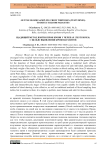
Gentle blood sampling from tortoises (Testudines) to detect blood parasites
Статья научная
Blood can be drawn from the jugular, brachial, femoral, ventral and dorsal coccygeal veins, occipital venous sinus, and heart from most species of tortoises and aquatic turtles. An alternative method for obtaining high-quality blood samples from tortoises of the genus Testudo for the detection of blood parasites by blood extraction using a medicinal leech ( Hirudo medicinalis ) has been proposed. One or two leeches were placed on each individual, depending on the body weight of the turtle. The time spent by leeches on blood sucking took from 20 minutes to 1 hour (average 35 minutes). After the pumped leeches fell off, they were immediately placed in sterile double-dish, where they contacted with a cotton swab moistened with ethyl alcohol in order to cause regurgitation of the sucked blood. In a comparative study of microscopic specimens prepared from blood samples of the spur-thighed tortoise obtained by two methods of exsanguination: cardiopuncture and medical leeches, no qualitative differences were found. In all specimens, blood cells and intraerythrocytic stages of blood parasites were equally suitable for identification. This method of exsanguination is also effective, as well as traditional methods of blood sampling from turtles, but in contrast to them, it is simple to perform, more humane and safer for these animals.
Бесплатно

